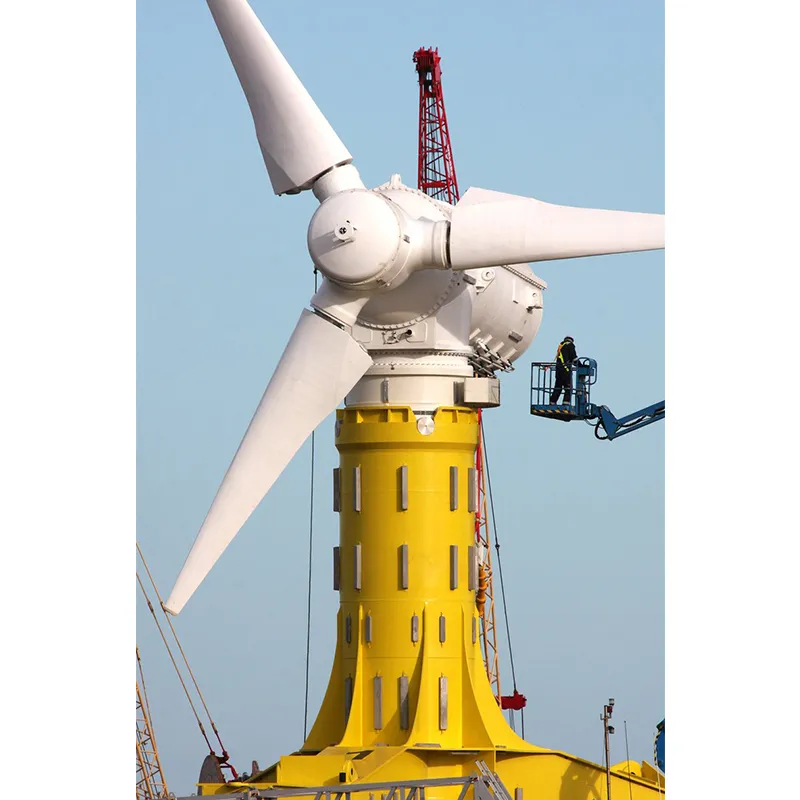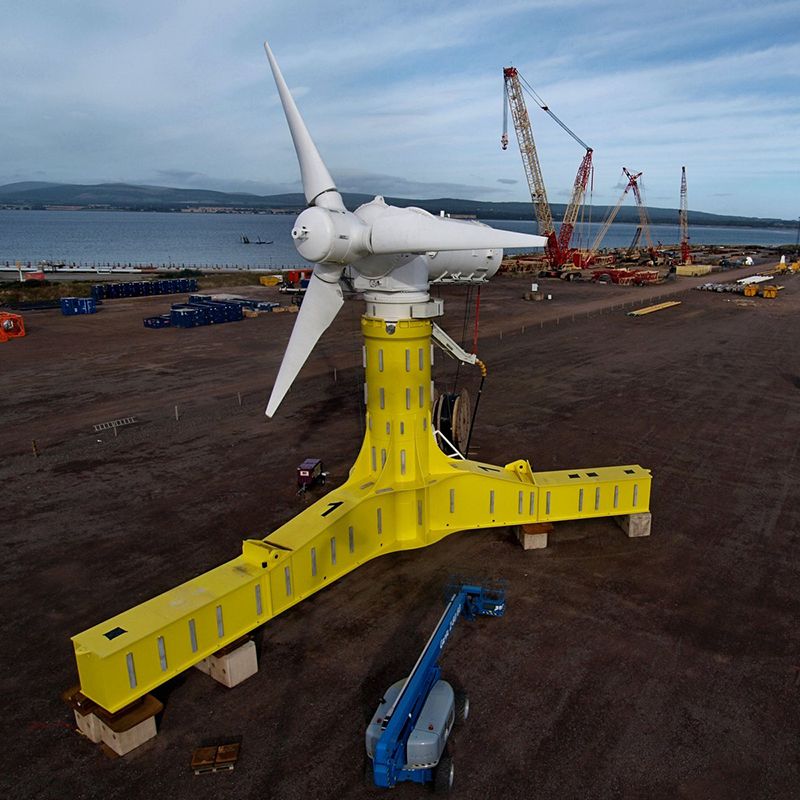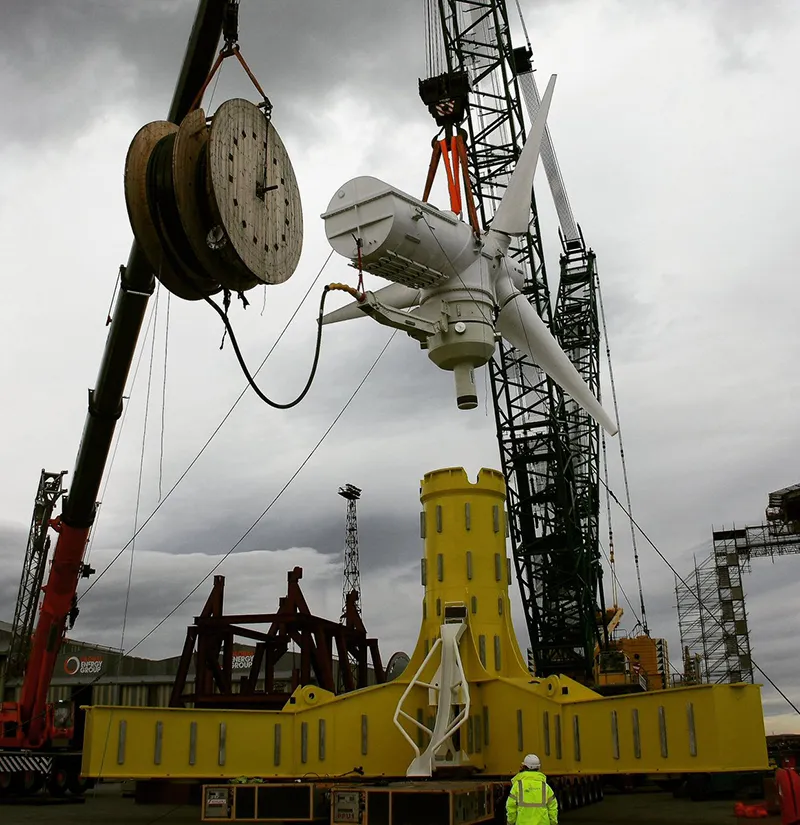Inside the World’s First Large-Scale Effort to Harness Tidal Energy
Next month, the UK-based company MeyGen will install four underwater turbines off the coast of Scotland
/https://tf-cmsv2-smithsonianmag-media.s3.amazonaws.com/filer/e7/a5/e7a52685-e0cb-4582-819c-7b71d4ceff9d/meygen-tidal-energy-field.jpg)
Tidal arrays are like the younger sibling of windmills—a bit smaller and slower spinning than their wind-loving brethren. But unlike windmills, they operate under many feet of water, spinning in the predictable movement of the ocean’s tides.
Over the course of the last decade, a handful of companies have taken individual tidal turbines for a successful spin. But the next wave of tidal energy is about to break. Recently, the UK-based tidal energy company MeyGen unveiled its plans for the world’s first multi-turbine tidal energy field.
The company is starting with a test of four turbines that will soon be deployed in the churning waters of the Inner Sound in Pentland Firth, Scotland. If the test goes swimmingly, they plan to deploy well over a hundred more over the next decade that would generate up to 398 megawatts of electricity—powering roughly 175,000 homes in Scotland.
One of the four turbines comes from Atlantis, a tidal power technology company headquartered in Edinburgh, Scotland, and the three others were developed by Glasgow-based Andritz Hydro Hammerfest. The devices stand some 85 feet tall, about the height of a five story house, and sport three blades that spin with a diameter spanning nearly 60 feet. While smaller than windmills, the turbines are still quite heavy, each weighing in at 65 tons—roughly the same as six African bush elephants.
The array will likely hit the water this October, says Cameron Smith, project development director of Atlantis Resources. The turbines have already been shipped to the site and undergone testing on shore. “All we need now is an appropriate tidal window and weather window and we'll be installing,” he says. Engineers assemble the turbine bases on land, and then, with a crane, lift them from a barge and lower them to the sea floor. Once submerged, each will have at least 26 feet of clearance at the lowest tides.
Tidal turbines have many advantages over other renewables, explains Andreas Uihlein, scientific project officer at the European Commission. First, the turbines are submerged underwater, completely out of sight.
Though some people revel in the beauty of solar or windmill farms, many consider them eyesores. The Block Island offshore windmill farm, the first of its kind in the United States, met largely broad appeal when it was installed this summer, because of its small size and promise to replace the island’s diesel generators. But the distaste for wind farms was abundantly clear with the uproar surrounding the 130-turbine Cape Wind project off of Martha’s Vineyard. So the positioning of the giant turbines well below the cresting waves is considered a plus.
The tidal turbines also generate a predictable supply of power. Unlike wind or solar that rely on the whims of the weather, researchers can actually calculate the tidal pull and the amount of energy these systems will generate. Though the power isn’t a constant supply, ebbing and flowing through the day, its predictability lessens the need to store large energy reserves.
The systems will also help with local employment. “There's the potential to generate 5,300 full-time equivalent jobs over the next three or four years,” says Smith. “I'm hugely proud that 43 percent of this first phase was manufactured using local supply chain.” Many of these new jobs require the same skills as the oil and gas industry, which means that this fledgling industry provides a new home for talented labor.
Pentland Firth’s Inner Sound and the individually deployed turbines have undergone extensive monitoring, showing few environmental impacts. Noise levels for turbines already churning away are well below a level that would cause damage, according to MeyGen’s environmental impact analysis. The biggest concern would be collisions with the marine mammals—particularly the harbor seal, whose populations have plummeted in recent years. But no collisions have yet been observed for the single turbine installations, according to a recent report from Annex IV, the body established by the International Energy Association Ocean Energy Systems to examine the environmental impacts of marine renewable energy.
It seems almost too good to be true.
That is because, of course, the story doesn’t end there. “There's always trade offs in energy generation. You could take every one of those statements and put an asterisk next to it,” says Brian Polagye, co-director of the Northwest National Marine Renewable Energy Center, a collaboration between the University of Washington, Oregon State University and the University of Alaska Fairbanks with the goal of advancing the commercialization of marine energy technology.
Though initial tests showed no environmental impact, even minor influences will become magnified as the company increases the number of turbines in the field. And, as the Annex IV report notes, most of the research has been focused on measuring the amount of noise the turbines generate, but few have identified how this level of noise could actually affect the behavior of marine animals. Though the noise levels are low, the sound could still interfere with animal communication, navigation or detection of prey.
There is also much still unknown about the durability of the turbines. Their placement underwater keeps them out of sight, but the corrosive marine environment could slowly eat away at the devices. They also suffer constant mechanical stress, buffeted about in the currents.
Though many companies have deployed individual units, none have been in the ocean for very long. Marine Current Turbines installed the first tidal turbine in Northern Ireland’s Strangford Lough in 2008. Now in its eighth year, this 1.2 MW spinner, composed of two separate turbines attached to a center platform, has been feeding the grid since its installation.
“The big challenge for almost every company is going to be, how are you going to do this at a cost that competes with other sources of energy?” says Polagye.
As a new industry, tidal energy has had its fair share of setbacks, with several companies, including the Ireland-based Wavebob Ltd., folding after failing to secure funding. But with improved designs, MeyGen and others are spinning their way back up to the top. Their long-term success relies in part on the government support for development and installation, explains Polagye.
The United Kingdom government works on what’s known as “market-pull mechanisms,” explains Polagye. In this system, the government pays the difference between the cost of the renewable energy and that of standard electricity. This system pulls the new companies into the market, allowing them to compete with the big dogs of energy. The United States government, however, uses push mechanisms, supplying grants for development but little help competing with other energy sources. In order for these systems to have a future in the U.S. market, says Polagye, the government needs to develop similar pull mechanisms for energy.
Though tidal currents aren’t strong enough along every coast to host one of these spinners, there are still many spots around the world with potential. In order for a site to be worthwhile, they must have some type of geographic restriction, like straits and fjords. This narrowing of the flowpath increases the speed of the water movement in the retreating or advancing tides, and therefore increases the energy recovered from the site.
“If you look at a map of the world and show all the [potential turbine] sites to scale, they'd look really tiny—you probably would have trouble seeing them,” says Polagye. “But if you were to aggregate them all together, you'd probably end up with a few hundred gigawatts of energy.” And though the world will likely never run completely on tidal energy, a few hundred gigawatts is nothing to shake your iPhone at. To put that amount in perspective, since 400 MW is expected to power 175,000 homes, one gigawatt could power roughly 500,000 homes.
A 2015 report from the European Commission’s Joint Research Center suggests that by 2018, there will be about 40 MW of tidal and 26 MW of wave energy undergoing installation. While tidal energy takes advantage of the tides, wave energy harnesses the energy from churning waves. Still in its early days of development, researchers are exploring different ways to do this—from long floating structures that “ride” the waves to massive bobbing buoys. Though wave energy lags behind tidal, according to the report, it has a global potential 30 times that of tidal energy, due to the large number of potential sites for deployment around the globe.
Where the field of tidal turbines will go in the next couple decades is a bit of a mystery.
“A lot of that depends on MeyGen,” says Polagye. “The turbine has to operate well and it has to not kill seals. If they do that, they’re definitely on a good trajectory.”
/https://tf-cmsv2-smithsonianmag-media.s3.amazonaws.com/accounts/headshot/Wei-Haas_Maya_Headshot-v2.png)



/https://tf-cmsv2-smithsonianmag-media.s3.amazonaws.com/accounts/headshot/Wei-Haas_Maya_Headshot-v2.png)